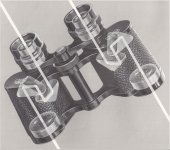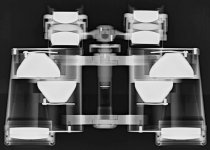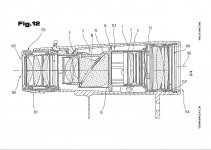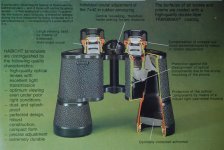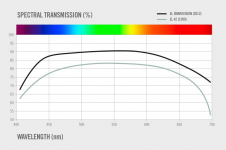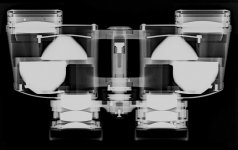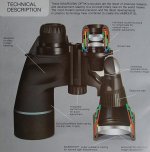John A Roberts
Well-known member

Dennis
I’ve picked a couple of illustrations to clearly show the differences in the number of air-to-glass surfaces
1) The 8x30 Deltrintem - the optical construction is the same as that of both Swarovski’s Habicht 8x30 W and 10x40 W
The first image is from the 1952 Carl Zeiss Jena catalogue (it also clearly shows the 90 degree offset of the 2 Porro prisms to correctly orientate the image)
The second is an x-ray image from Arek at Allbinos
(for both images see: https://www.allbinos.com/170.1-article-Legendary_binoculars_-_Carl_Zeiss_Jena_Deltrintem_8x30.html )
They both show:
7 lenses in 4 groups, plus 2 seperate prisms, for a total of 12 air-to-glass surfaces
EDIT: in contrast to the Zeiss, both the Habicht 8x30 W and 10x40 W have a 6 element eyepiece - 3 pairs in 3 groups - for a total of 8 lenses in 4 groups
However, the number of air-to-glass surfaces in the Zeiss and Habicht remain the same. See Henry's post #46 below
2) The EL Swarovision
This cross section is from the Swarovision patent
It clearly shows:
10 lenses (sic) in 8 groups, plus 2 seperate prisms, for a total of 20 air-to-glass surfaces *
So the EL SV has 12 glass components per side - 10 lenses and 2 prisms, vs the 12 air-to-glass surfaces of the Habicht
* as I previously indicated there’s an error in this illustration - one of the lenses in the eyepiece assembly has not been shaded in - so only 9 of the 10 lenses are are visible
see https://www.birdforum.net/showpost.php?p=3843650&postcount=10
However, as the missing lens is part of a cemented doublet it does not effect the number of air-to-glass surfaces, and otherwise the illustration is easy to follow
Also as previously indicated in this thread, there are of course additional transmission considerations including:
- the volume of glass along the optical axis;
- the type of glass (optical density and dispersion), and;
- coating efficiency (of anti-reflective coatings on all air-to-glass surfaces, plus phase and dielectric coatings on the non-Totally Internal Reflection surfaces of Schmidt-Pechan roof prisms)
John
I’ve picked a couple of illustrations to clearly show the differences in the number of air-to-glass surfaces
1) The 8x30 Deltrintem - the optical construction is the same as that of both Swarovski’s Habicht 8x30 W and 10x40 W
The first image is from the 1952 Carl Zeiss Jena catalogue (it also clearly shows the 90 degree offset of the 2 Porro prisms to correctly orientate the image)
The second is an x-ray image from Arek at Allbinos
(for both images see: https://www.allbinos.com/170.1-article-Legendary_binoculars_-_Carl_Zeiss_Jena_Deltrintem_8x30.html )
They both show:
7 lenses in 4 groups, plus 2 seperate prisms, for a total of 12 air-to-glass surfaces
EDIT: in contrast to the Zeiss, both the Habicht 8x30 W and 10x40 W have a 6 element eyepiece - 3 pairs in 3 groups - for a total of 8 lenses in 4 groups
However, the number of air-to-glass surfaces in the Zeiss and Habicht remain the same. See Henry's post #46 below
2) The EL Swarovision
This cross section is from the Swarovision patent
It clearly shows:
10 lenses (sic) in 8 groups, plus 2 seperate prisms, for a total of 20 air-to-glass surfaces *
So the EL SV has 12 glass components per side - 10 lenses and 2 prisms, vs the 12 air-to-glass surfaces of the Habicht
* as I previously indicated there’s an error in this illustration - one of the lenses in the eyepiece assembly has not been shaded in - so only 9 of the 10 lenses are are visible
see https://www.birdforum.net/showpost.php?p=3843650&postcount=10
However, as the missing lens is part of a cemented doublet it does not effect the number of air-to-glass surfaces, and otherwise the illustration is easy to follow
Also as previously indicated in this thread, there are of course additional transmission considerations including:
- the volume of glass along the optical axis;
- the type of glass (optical density and dispersion), and;
- coating efficiency (of anti-reflective coatings on all air-to-glass surfaces, plus phase and dielectric coatings on the non-Totally Internal Reflection surfaces of Schmidt-Pechan roof prisms)
John
Attachments
Last edited:




